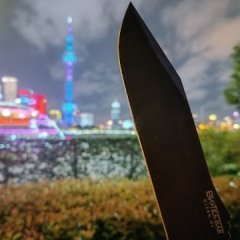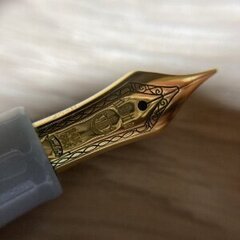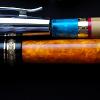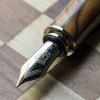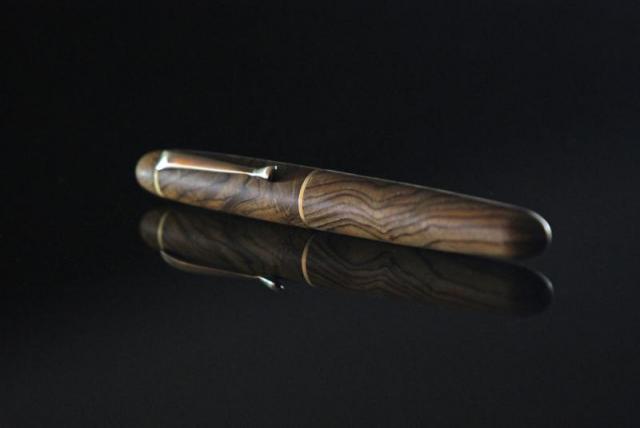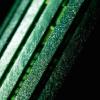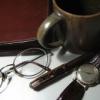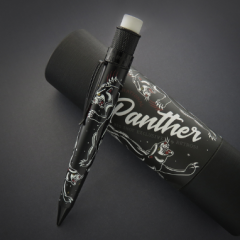Search the Community
Showing results for tags 'wood'.
-
Back to the year of 2022, it was the year of Tiger. This pen was therefore purchased before the new year holiday. I was quite concerned with wood cracking. After 2 years in storage, wood is still intact. 10/10 body work. It is not a small pen, almost same feeling as gripping the MB149. 9/...
- 2 replies
-
- jinhao
- jinhao9056
-
(and 2 more)
Tagged with:
-
I might be retiring from teaching at the end of this year, and I am thinking that I might get myself an all-wood pen (section is wooden, also) to celebrate. I might even do a special order. I won't be able to spend more than 500USD. Any recommendations for a maker or brand? I really know n...
-
Hello there, this is my first post here. Currently I'm using the decimo and pro gear slim the most and I enjoyed both metal and resin pens. But I wonder are there any good wooden pens? I would like to have one as I like the touch of wood. I have seen pilot custom maple and sailor preciou...
-
india Any suggestions for Indian wooden handmade pens?
Srjan posted a topic in India & Subcontinent (Asia)
I do not know if SYAHI pens is still operating but they make beautiful wooden pens. There is also Lotus Shikhar in Sandalwood and I know Lotus also makes sandalwood pens in other models. It will be great if there is someone like Ryan Krusac in India, who makes pens in different types of woods. -
This is my first review, so if you can think of any part of the pen I did not cover then please ask questions below. This is the beautiful Magnifica Amalfi from Delta. The pen has a 14k extra-fine nib and comes with a gorgeous olive wood barrel with prominent grain. The rest of the pen is cons...
-
Storio Wooden Fountain Pen Case Review
ace117 posted a topic in Paper & Pen Paraphernalia Reviews and Articles
Hey guys! During my recent travels to Japan, i found a unique wooden fountain pen case from Storio. I'd never heard of the brand before but the moment i saw the case i fell in love with the way it looked and felt, so I just had to get one! I thought I'd just shed some light on this relatively unknow... -
Has anyone tried one of these Vindolanda pens made from 2000 year old oak dug up at the archaeological site in northeast England? I think its a cartridge converter pen. https://www.vindolanda.com/shop/vindolanda-wood-ink-pen From a Reddit post I found it looks like a F/M-ish nib. https://www....
- 5 replies
-
- roman
- archaeology
-
(and 3 more)
Tagged with:
-
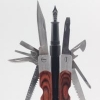 Hello Friends and Pen Enthusiasts, I plan to manufacture "Luxury HandMade Fountain Pens". I want your suggestions with reference to the following:- 1. Which Material would you suggest I should use? a.) ebonite b.) teak wood c.) resin d.) any other then please suggest. 2. Which NIB is the...
Hello Friends and Pen Enthusiasts, I plan to manufacture "Luxury HandMade Fountain Pens". I want your suggestions with reference to the following:- 1. Which Material would you suggest I should use? a.) ebonite b.) teak wood c.) resin d.) any other then please suggest. 2. Which NIB is the...- 87 replies
-
- pen
- fountain pen
-
(and 8 more)
Tagged with:
-
I finally took the plunge finally and bought an Izumo (Tagayasan) after going through some lovely reviews from my fellow fpners. I could not find a review of the matte version at fpn before buying this. Here is also a link to my blog with some more pics: Platinum Izumo Tagayasan - Matte Review...
- 67 replies
-
- izumobombay blackwood
- matte
-
(and 7 more)
Tagged with:
-
Gvfc Platino Intuition Pernambuco (Price&production Line)
Hyukken posted a topic in Other Brands - Europe
GvFC Platino intuition has 3 colour option, sure Ebony and Grendilla are both great, but I really like the Pernambuco wood. By the time I spend on trying to buy it from internet, I realize its not an easy task. And my friend tells me that Pernambuco product has been stopped. So here comes some q... -
Hello FPN! This is only me second FPN post, so I am going to reintroduce myself- My name is Sanay Shah, and I am a 21 year old mechanical engineer and the co founder of a brand called Syahi, that handcrafts wooden fountain pens(from scratch-these are NOT kit pens. The brass parts, section, rings e...
- 2 replies
-
- pens
- indianpens
-
(and 8 more)
Tagged with:
-
Hello! My name is Sanay Shah, and I am the co founder of a brand called Syahi(urdu for 'ink') based out of Bombay, India. We handcraft pens using exotic hardwoods that have been seasoned for years at end. We haven't really launched yet-the past year, we made a bunch of pens, got feedback from ou...
- 20 replies
-
My first italian fountain pen - the SEC Magia (magic), that wood artist Stefano Costatini has made for me: It is made of rosewood that has been specially treated so that ink and sweat cannot harm it . The metal parts of the pen are from sterling silver and goldplated. They are also made at Stefan...
-
http://i175.photobucket.com/albums/w143/nicholasyzh/StaedtlerInitiumLignum1.jpg Staedtler - a German brand synonymous with pencils and technical instruments in Europe - had launched its new "Staedtler Premium" range of fountain pens. Interestingly, the Staedtler Foundation owns all shares of the...
-
http://inks.pencyklopedia.pl/wp-content/uploads/De-Atramentis-Wood-Brown-nazwa.png Present test ink De Atramentis Wood (Brown) with a nice nutty color and very good properties, namely: the perfect flow, pen glides across the paper photocopier perfectly, good drying time and a nice saturation. If y...
- 3 replies
-
- de atramentis
- wood
-
(and 1 more)
Tagged with:
-
I've recently added a Moonman M1 in brass and Tiger wood to my collection and am glad I did. The pen was was about $12 on Taobao. The pen is relatively long and slim. The section doesn't taper much at all. The cap takes about 3 turns to remove. The cap could post, I suppose, but the threads wou...
-
Greetings all, Do we have a "Japanese pen brag page" , like the "What Parker are you using this day?" page or the Pelikan "Whats the most recent addition to the flock?" page. A interesting brag page is the "Whats the most recent MB purchase?" These pages allow us to share our enthusiasm, joy and...
-
I found this artist's case for paints, brushes and other materials in a Japanese surplus store, and decided to convert it into another case for pens. Some of you will recall that I turned a similar case (a larger one) into a case for pens five years ago: http://farm9.staticflickr.com/8224/84432806...
-
Hello Everyone, I don't announce this kind of thing very much, but I wanted to share it with you kind people because this is one of my favorite places to go on the internet, and the FPN community is what makes it so for me. I am coming out with my latest production pens since the Icarus. I am ve...
- 6 replies
-
- flex pen
- desiderata
-
(and 8 more)
Tagged with:
-
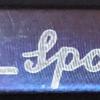
Wood Pens And Cracking Question. Montegrappa Heartwood.
sub_bluesy posted a topic in Fountain & Dip Pens - First Stop
I just picked up a new Montegrappa Fortuna Heartwood in teak the other day from an authorized dealer. I received the pen and it looked fine on the initial inspection but after looking at the body under mild magnification, I can see several cracks, about 3, in the pen body lengthwise starting at the...- 6 replies
-
- montegrappa
- heartwood
- (and 4 more)
-
Hello, One of my acquaintances will be in Japan in the next couple of months and has very kindly offered to bring back a small package for me. As part of this package, I was looking to buy a Japanese FP that is challenging to get in India. We either have to buy it from online sources) from Japan (...
- 25 replies
-
- help
- recommendation
-
(and 3 more)
Tagged with:
-
Hello, penfolks! This review will be of limited use, as a. the pen in question is brand-new to me at the time of this writing and therefore still suffused with new-purchase glow; b. I’m writing with it as regularly as I can, but I’m still only a couple of fills in, which means I haven’t had too muc...
-
Paolo Cerulli Wood Fountain Pen This beautiful fountain pen is elegant and affordable. The body is walnut toned with pewter toned trim and comes equipped with a hooded steel nib. The filling system uses a standard International sized ink cartridge, which is universally available and easy to loca...
-
- paolo cerulli
- wood
-
(and 1 more)
Tagged with:
-
http://i.imgur.com/R9qfTpB.jpg *I apologize for the poor quality iPhone photos taken in my poorly-lit apartment -- I'll borrow a dSLR to get some decent ones before I do a full review. After 13 months my Hakase is finally here! Since I ordered it last December, I've been anxiously awaiting this li...
-
A bunch of Omas that were offered at significantly (IMHO of course) reduced prices, have landed on my desk. I can afford to keep 3, so the rest would need to go back. The wish, of course is to keep all of them, but my banker vehemently disagrees. Do note that all of them were offered around the same...


